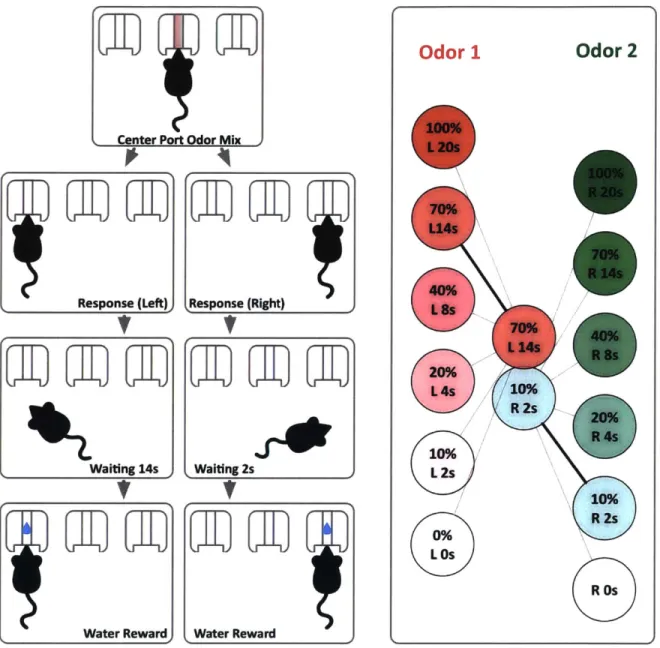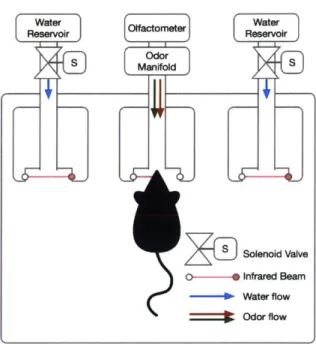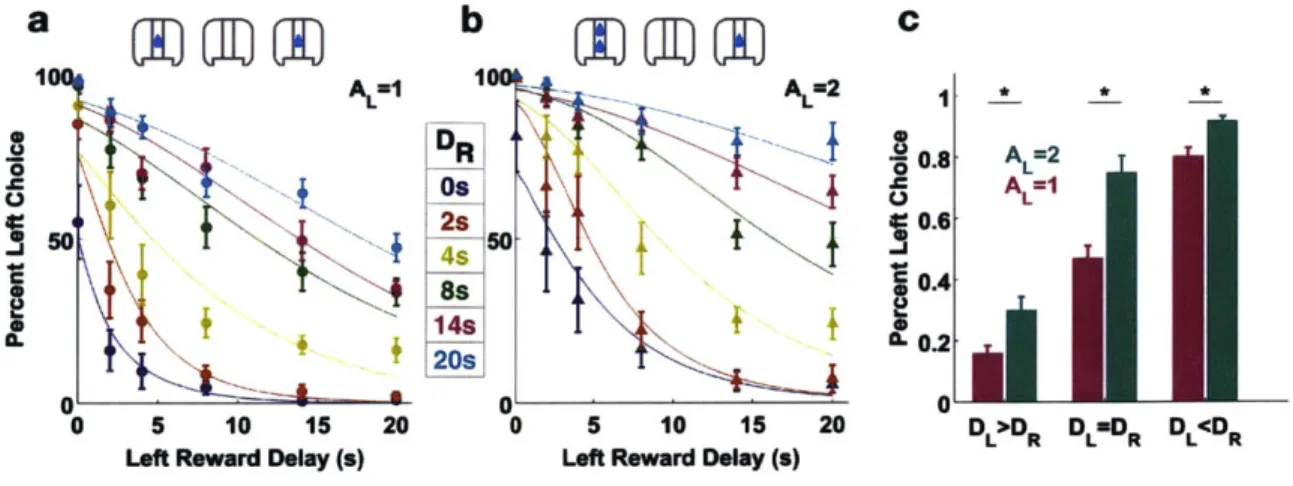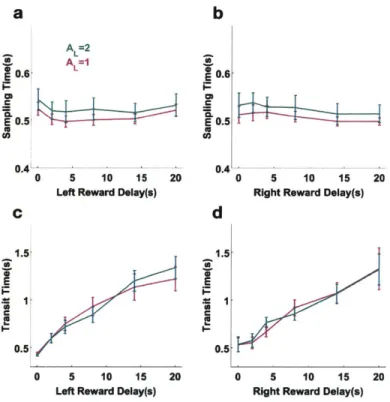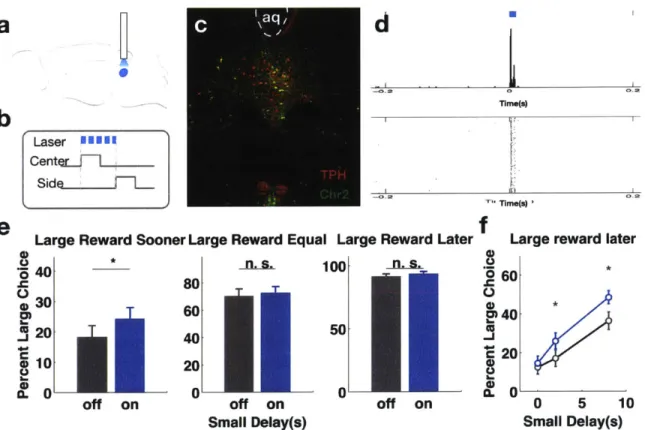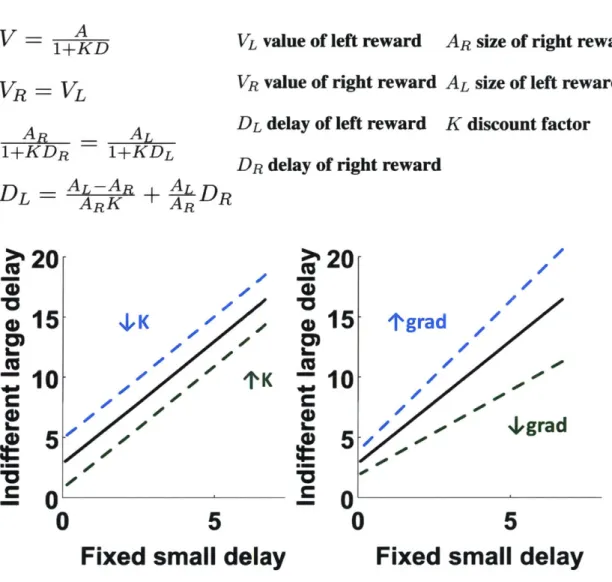Control of Intertemporal Choice by Dorsal Raphe
Serotonergic Neurons
by
Sangyu Xu
Submitted to the Department of Brain and Cognitive Sciences
in partial fulfillment of the requirements for the degree of
Doctor of Philosophy in Neuroscience
at the
MASSACHUSETTS INSTITUTE OF TECHNOLOGY
September 2016
@
Massachusetts Institute of Technology 2016. All rights reserved.
Author...Signature
redacted
DepartnYent of Brain and Cognitive Sciences
August 12, 2016
Signature redacted
Certified
by....
...
Susumu Tonegawa
Picower Professor of Biology and Neuroscience
Thesis Supervisor
Aceped~Signature
redacted
Accepted b
..
Matthew A. Wil n
Sherman Fairchild
rofessor of Neuroscience and Picower Scholar
Director of Graduate Education for Brain and Cognitive Sciences
MASSACHUTT IiTUTE OF TECHNOLOGY
Control of Intertemporal Choice by Dorsal Raphe
Serotonergic Neurons
by
Sangyu Xu
Submitted to the Department of Brain and Cognitive Sciences on August 12, 2016, in partial fulfillment of the
requirements for the degree of Doctor of Philosophy in Neuroscience
Abstract
While animals tend to prefer immediate rewards to delayed ones [1], delayed gratifi-cation is often advantageous [2]. Appropriate choice about future rewards is critical for survival. The dorsal raphe serotonergic neurons have been long implicated in the control of temporal discounting of reward [3] [4], but it is not clear whether their activities in fact direct the decision making process. In this thesis, I designed a cued intertemporal choice task for mice that allows the combination of highly specific ge-netic manipulations with sophisticated behavioral interrogations. The task utilizes odors to communicate upcoming reward contingencies to the mouse subjects. I found that optogenetically augmenting or silencing the activities of dorsal raphe seroton-ergic neurons precisely at decision epochs resulted in an increase or a reduction in the choice for the delayed and larger reward, respectively. These manipulations do not alter the subjects' choice in trials involving immediate rewards, suggesting that serotonin might only be important for conditions in which difficult trade-offs are re-quired. I also demonstrated that the nucleus accumbens, a major component of the mesolimbic reward pathway, is a possible downstream target of the aforementioned serotonin action. Taken together, these results show that serotonergic neurons regu-late inter-temporal choice behavior bidirectionally, possibly through actions in nucleus accumbens.
Thesis Supervisor: Susumu Tonegawa
Acknowledgments
I am grateful to my thesis adviser Susumu Tonegawa for his constant support and for
letting me explore a complex arena with great freedom. My committee members Earl Miller, Michale Fee and Nao Uchida were incredibly generous with their time and advice on the project throughout its development. My collaborators Emily Hueske, Gishnu Das and Kean Bustamante and I spent countless hours together building things from setup to ideas, and I will always cherish the friendship. Timothy O'Connor liberally shared his expertise in software and hardware, which led to the fruition of the behavior paradigm. Chanel Lovett and C. A. Twiss provided me with invaluable technical assistance, without which I would have seriously stumbled. I thank Arek Hamalian, Dennis King, Carrie Ragion, Candy Carr, Liam Brenner, Mike Ragion, Katie Mulroy and Nayiri Arzoumanian for help and support. I am also indebted to the postdocs and fellow students at the Tonegawa Lab, for all the philosophical and technical discussions about the brain and life in general. To my BCS 2008 classmates and other BCS friends I met over the years, I owe a great deal of fun and personal growth alike. I could not have done this work at all without the support of Mdm. Wan Chiew Inn and Ms. Susan Ong. I thank my parents for believing in me and helping me believe in myself. Finally, I thank Jeremy for being the pillar that he is in my life through this intense and often difficult journey.
This work was partially supported by a grant from the Agency for Science, Tech-nology and Research, Singapore and RIKEN-MIT Center for Neural Circuit Genetics.
The Ant and the Grasshopper
In a field one summer's day a Grasshopper was hopping about, chirping and singing to its heart's content. An Ant passed by, bearing along with great toil an ear of corn he was taking to the nest.
"Why not come and chat with me," said the Grasshopper, "instead of toiling and
moiling in that way?"
"I am helping to lay up food for the winter," said the Ant, "and recommend you
to do the same."
"Why bother about winter?" said the Grasshopper; "we have got plenty of food
at present." But the Ant went on its way and continued its toil.
When the winter came the Grasshopper had no food, and found itself dying of hunger, while it saw the ants distributing every day corn and grain from the stores they had collected in the summer. Then the Grasshopper knew:
"IT IS BEST TO PREPARE FOR THE DAYS OF NECESSITY."
1 Introduction to Intertemporal Choice and Choice Impulsivity 1.1 Temporal Discounting of Reward . . . .
1.2 Choice Impulsivity ... ...
1.3 Behavior Paradigms for Intertemporal Choice . . . . 1.3.1 Pigeons and Rodents . . . . 1.3.2 Humans and Non-Human Primates . . . . 1.3.3 Motivations for a Cued Intertemporal Choice Task and Olfac-tion as a Mode of CommunicaOlfac-tion . . . .
2 The Odor-Guided Intertemporal Choice (OGIC) Task for Mice
2.1 Design Goals 2.1.1 2.1.2 2.1.3 2.2 Task 2.2.1 2.2.2 2.2.3 2.2.4 2.2.5
Automated Behavioral Testing Isolating the Decision Epoch . Testing the Choice to Wait . . .
Description . . . . Apparatus . . . . Subjects . . . . Shaping . . . . Final Task . . . . Example Psychometric Curves
2.2.6 Hyperbolic Discounting of Reward Value in the Present Task
2.2.7 Gross Motor Aspects of Behavior . . . .
2.3 OGIC Task is a Good Assay for Intertemporal Choice . . . . 19 20 21 22 22 24 24 27 . . . . 2 7 . . . . 2 7 . . . . 2 7 . . . . 2 8 . . . . 2 8 . . . . 2 8 . . . . 3 0 . . . . 3 0 . . . . 3 1 . . . . 3 2 33 34 34
Contents
3 Introduction to Dorsal Raphe Serotonergic Neurons 39
3.1 Serotonin Synthesis and Cellular Features . . . . 39
3.2 Anatomy of the Dorsal Raphe Nuclei . . . . 40
3.3 Serotonin Receptors . . . . 40
3.4 Physiology of Serotonergic Neurons in Behavior . . . . 41
3.5 Hypotheses about Serotonin Function in Decision-Making . . . . 41
3.5.1 The Negative Prediction Error Hypothesis (The Dopamine-Serotonin Opponency Theory) . . . . 42
3.5.2 The Discount Factor Hypothesis . . . . 42
3.5.3 Reward-Encoding Hypothesis . . . . 43
3.6 Conflicts between the Hypotheses . . . . 43
4 Raphe Serotonergic Neurons Suppress Impulsive Choice in Difficult Trade-offs in the OGIC Task 47 4.1 A im . . . . 47
4.2 Materials and Methods . . . . 47
4.2.1 Subjects and Training . . . . 47
4.2.2 Viral Transfection and Optical Fiber Implantation . . . . 48
4.2.3 Behavior Testing . . . . 48
4.2.4 Data Analysis . . . . 49
4.3 R esults . . . . 49
4.3.1 Optogenetic Manipulations of DR serotonergic Cell Bodies Al-tered Subjects' Delay Preference in OGIC Task . . . . 49
4.3.2 Optogenetic Manipulations of Serotonergic Cell Bodies Were Sensitive to Reward Magnitude . . . . 54
4.3.3 Optogenetic Manipulations of Serotonergic Cell Bodies Did Not Affect Sampling Time or Transit Time . . . . 54
4.4 D iscussion . . . . 58
5 Nucleus Accumbens and Intertemporal Choice 65 5.1 Nucleus Accumbens . . . . 65
5.2 Nucleus Accumbens and Impulsive Choice and Involvement of Dopamine
and Serotonin . . . . 66
6 Nucleus Accumbens as a Site for Serotonin Suppression of Impulsive Choice 69 6.1 A im . . . . 69
6.2 Materials and Methods . . . . 69
6.2.1 Subjects and Training . . . . 69
6.2.2 Viral Transfection and Optical Fiber Implantation . . . . 69
6.2.3 Behavior Testing . . . . 70
6.2.4 Data Analysis . . . . 70
6.3 R esults . . . . 71
6.3.1 Optogenetic Manipulations of Serotonergic Projections in Nu-cleus Accumbens Altered Subjects' Preference in OGIC Task . 71 6.3.2 Optogenetic Manipulations of Serotonergic Projections in Nu-cleus Accumbens Were Sensitive to Reward Magnitude . . . . 72
6.4 D iscussion . . . . 75
7 Conclusion and Future Directions 79 7.1 M ain Findings . . . . 79
7.1.1 Mice Can Use Odor Cues to Perform a Cued Intertemporal C hoice Task . . . . 79
7.1.2 Transient Activity of DR Serotonergic Neurons Causally Con-trols Delay-Size Trade-off in Intertemporal Choice . . . . 80
7.1.3 NAc Acts as a Target Structure for Serotonergic Influence in Intertemporal Choice . . . . 80
7.2 Future Direction . . . . 81
A Mazur's Derivation of Indifference Functions for Exponential and Hyperbolic Discounting 85 A.1 Hyperbolic Discounting . . . . 85
A.2 Exponential Discounting . . . .
B Anterograde and Retrograde Tracing of Neuronal
Dorsal Raphe to the Nucleus Accumbens
B.1 Anterograde Tracing of DR-NAc Projections . . . .
B.1.1 Materials and Methods . . . . B .1.2 R esults . . . . B.2 Retrograde Tracing of DR-NAc Projections . . . . . B.2.1 Materials and Methods . . . . B .2.2 R esults . . . . 86 Projections from 91 . . . . 91 . . . . 91 . . . . 92 . . . . 92 . . . . 92 . . . . 92
C Validation of Viral Transfection of Opsin Constructs into Sert-Cre Mice by in vivo Multiunit Recording in Anaesthetized Animals 99 C .1 Subjects . . . . 99
C.2 Materials and Methods . . . . 99
List of Figures
1-1 Discounting functions. . . . . 20
1-2 Preference reversal . . . . 21
2-1 Task structure and cue delay correspondence. . . . . 29
2-2 Operant chamber connected to olfactometer. . . . . 31
2-3 Psychometric curves for a group of subjects. . . . . 32
2-4 Indifference function of the sample group. . . . . 33
2-5 Cue sampling time and reaction time. . . . . 35
4-1 Supression of Arch-expressing DR sertonergic neurons suppresses im-pulsive choice. . . . . 50
4-2 Light delivery to GFP-expressing DR serotonergic cell bodies did not altered subjects' delay preference in OGIC task. . . . . 51
4-3 Activation of ChR2-expressing DR sertonergic neurons suppresses im-pulsive choice. . . . . 52
4-4 Illustrations for Indifference Function Parameter Changes. . . . . 55
4-5 Psychometric curves for the dorsal raphe activation and inactivation experim ents. . . . . 56
4-6 Indifference function for dorsal raphe activation and inactivation ex-perim ents. . . . . 57
4-7 Estimates for the gradient of the indifference function and discount factor K . . . . . 57
4-8 Optogenetic manipulations did not affect reaction times for trials where the large reward was more delayed than the small reward. . . . . 59
6-1 Inactivation of dorsal raphe sertonergic neurons promotes impulsive
choice. . . . . 72 6-2 Psychometric Curves for the Dorsal Raphe to Nucleus Accumbens
Pro-jection Activation and Inactivation Experiments . . . . 73 6-3 Indifference Function for Dorsal Raphe to Nucleus Accumbens
Activa-tion and InactivaActiva-tion Experiments. . . . . 74 6-4 Estimation of the gradient of the indifference function and discount
factor. . . . . 74
A-1 Predictions about indifference functions for both hyperbolic and
expo-nential discounting. . . . . 87
B-1 Anterograde tracing from dorsal raphe to nucleus accumbens. .... 93
B-2 Retrograde tracing from NAc with CTB 555. . . . . 94 B-3 Retrograde tracing from NAc with CTB 555 counterstained with TPH
List of Tables
Chapter 1
Introduction to Intertemporal
Choice and Choice Impulsivity
Animals have to make decisions about time all the time. The ants in the famous Aesop's fable have to choose between eating the food they harvested while it was abundant in the summer, and storing the food for later during the winter when it would be scarce. This is an illustration of an intertemporal choice, choosing between options over time. We choose between reaching for a cigarette and preserving long-term health, and we debate between truancy and getting an education for later em-ployability. To spend or to save, to procrastinate or to work: intertemporal decisions pervade our daily life. On a larger scale, we have to choose collectively as a society. Do we select a political candidate who promises to cut taxes or one who is devoted to long-term civil projects that will benefit us as a group for many years to come? Clearly, these choices that we make about time have implications in diverse arenas such as health, economics and politics.
Given the choice, animals tend to prefer a reward that will arrive sooner than one that will arrive later [1]. In some scenarios, however, the delay to the reward and the size of the reward create a dilemma for the decision maker. For example, while one has no difficulty choosing between receiving 10 dollars today and 10 dollars in a week, one might hesitate to choose between 10 dollars today and 20 dollars in a week. The
I
latter scenario, where a delay-size trade-off has to be performed by the decision maker, is a more interesting case of intertemporal choice. Many problems life poses involve such decisions, in which we must choose between wanting more and wanting it sooner.
How we choose between reward options that are differently delayed is governed
by a few decision variables. Obviously, these include the size of the rewards available
and the delay to the rewards. A third variable, our discount function, governs how we valuate the future reward.
1.1
Temporal Discounting of Reward
\
U
learning, forcer to
Temporal discounting of reward
is a decrease in the subjective value of a reward as it is
de-Hyperbolic
Exponential layed into the future. It is also referred to as delay
discount-ing in animal experimental
psy-chology. This decrease in value is steep and negatively accel-erated, and is often described with a hyperbolic function,
ex-Time
ponential function or some
com-Figure 1-1: Discounting functions. bination of both (Fig. 1-1). In
the framework of reinforcement temporal discounting can be viewed as the loss of effectiveness for a rein-reinforce an action or a conditioned stimulus.
A constant K, the discount factor, determines how steep the discount function
is. Different individuals have different discount factors [5] . An individual's discount factor has been shown to be at least partially hereditary [6], and associated with
age [7], drug use [8] and mental health conditions [9] [10]. As discount factor could be considered an individual trait, it is possible that the ants and the grasshoppers in the fable have different discount factors.
Now, back to the example choice between receiving 10
dol-Larger, More Delayed Reward lars today and 20 dollars some
Smaller, More Immediate Reward time in the future. If one is asked
B A to pick between 10 dollars
to-day and 20 dollars in a week,
10 dollars today might sound
very enticing. However, if the two options are similarly spaced
Time apart but occur much further
into the future, say 10 dollars
Figure 1-2: Preference reversal: When the choice point
is at A, and the two options are offered soon into the in 50 days versus 20 dollars in future, the subjective value for the small, more imme- 57 days, 20 dollars in 57 days
diate reward is higher; however, when the two options
are far away into the future, such as when the choice appeals more to most people. point is set to be at B, the larger reward is more prefer- This phenomenon is called
pref-able. This is a feature of hyperbolic discount function.
Adapted from Ainslie(1981). erence reversal [11] (Fig. 1-2).
As Ainslie demonstrated in his analysis, preference reversal can only occur when the subject has a non-exponential discounting function, e.g. it holds for hyperbolic discounting.
1.2
Choice Impulsivity
Impulsivity, acting prematurely without foresight, is a maladaptive behavior. Impul-sive behavior can be divided into three categories: reflection impulsivity refers to not sampling evidence enough before making a response; impulsive action refers to the inability to suppress a motor response; impulsive choice refers to choosing a more
immediate reward over a larger reward that is more delayed. The type of impulsivity we deal with in intertemporal choice is choice impulsivity i.e. a failure to choose to delay gratification. Choice impulsivity is a feature of many psychiatric conditions, such as ADHD, mania and substance abuse.
1.3
Behavior Paradigms for Intertemporal Choice
Intertemporal choice is a problem that has attracted the attention of economists, psychologists and animal behaviorists alike. As a result of a history of convergent effort, the methods of investigating intertemporal choice are as diverse as the people interested in it. I review below behavior paradigms that have been used over the years to investigate how animals, including people, make choices about rewards in time.
1.3.1
Pigeons and Rodents
Non-primate intertemporal choice tasks can be split into two main categories:
sys-tematic tasks [12] and adjusting tasks [13] [14] [15] [16].
In systematic tasks, the experimenter decides on a set of delay and size contingen-cies, and tests the subjects systematically on them, only changing variables between sessions. In most cases, the tasks are not cued. Sometime the free choices are pre-ceded with a block of forced choices, so that the subject can be sure to sample the contingencies on both sides. These tasks have a range of shortcomings. First, since the subjects are not informed trial-by-trial about upcoming contingencies, they have to remember what previous trials entailed, and then make their choice. This leads to a memory confound in any effect found in the subjects' preferences. Second, since often the delay contingencies are varied by session, or by blocks of trials, there is no efficient way of randomizing the contingencies. Third, when subjects respond to blocks of the same reward contingencies, they may not make every decision in real-time, since it is good enough to rely on the last decision. This amplifies the influence of the previous trial on the current choice and may result in trials where the decision epoch is absent. In adjusting tasks, the reward contingencies are adjusted according to the
be-havioral responses of the subjects. For example, a rule could be set to increase the delay to a particular reward option if the subject chooses it at high frequencies, and decrease the delay to that option if the subject fails to choose it. Adjusting tasks aim to find indifference points by titrating one of the independent variables. Pigeons and rats have been found to discount hyperbolically in a series of adjusting procedures
[17] (See his reasoning and derivation for the indifference function in Appendix A).
Adjusting tasks share some of the pitfalls of the systematic tasks, such as a lack of guaranteed real-time decision epochs. In addition, adjusting tasks do not stabilize consistently, even over long periods of training, and the subjects do not respond to any rapid changes in reward contingencies [18]. The biggest problem with adjusting reward contingencies across testing is the introduction of other confounding variables, probably learning-related, into the testing of decision-making, leading to erroneous conclusions. For example, the involvement of orbitofrontal cortex (OFC) in intertem-poral choice has been a point of contention. OFC was found to promote impulsive choice [15], suppress impulsive choice [16] or both depending on context [19]. The effect seemed to depend on whether OFC was lesioned before or after training. Con-sidering especially that OFC is critically involved in the acquisition of reward value representations, the conflict in the OFC delay discounting results seems to be due to a learning effect. This mystery was partially clarified when rats were lesioned in OFC after training in a 6-arm maze, which cued the rats about the delay contingencies associated with the arms. No effect was found [20]. OFC appears not to be involved in delay discounting per se.
The 6-arm maze version of the delay discounting task was a marked improvement on previous tasks. The crucial component that the maze task provided was cue. When rodents could be cued, trials could be randomized rapidly, decorrelating the preference from many other variables. While it was probably very labor intensive, it was very much like a primate task.
1.3.2
Humans and Non-Human Primates
In humans, a delay discounting task in a systematic and cued form is very simply administered. Most human already speak a language the experimenter is able to communicate in, or they can be taught quickly to look at a computer screen where the size or color of certain cues represent reward contingencies [21] [22]. Monkeys typically can be taught the latter [23]. As mentioned above, cueing the subjects allows the randomization of trials, which in turn allows the isolation of decision epochs. These epochs are essential for monitoring real-time neural activities relevant to the decisions, and for dynamic transient manipulations.
1.3.3
Motivations for a Cued Intertemporal Choice Task and
Olfaction as a Mode of Communication
Sections 1.3.1 and 1.3.2 make it abundantly clear that there is a need to design a rodent intertemporal task with cues. Rodents are much lower maintenance and faster in growth and reproduction than monkeys. Transgenic mice have revolutionized the study of many aspects of biology, including neuroscience. Optogenetics, still very much a difficult technology in monkeys, is extremely accessible in mice.
One of the hurdles with using mice is communication. The final task we want to achieve contains complex rules and requires mice to respond to large arrays of stimuli. Hence, we need a mode of communication that is quick to learn and is quantitative. Mice, as it turns out, see terribly, but hear much better and smell extremely well. It was demonstrated that olfactory cues were efficient conditioned stimuli that worked on very fast timescales [24], and at a high level of discrimination between concen-tration levels [25]. These are the threads that inspired the design of an odor-guided intertemporal choice task. The task is done with an apparatus consisting of an operant chamber and an olfactometer. The setup is described in the next chapter.
Chapter 2
The Odor-Guided Intertemporal
Choice (OGIC) Task for Mice
In this chapter, I describe a novel cued intertemporal choice task I have designed for mice, and briefly describe sample behavior data from the task.
2.1
Design Goals
2.1.1
Automated Behavioral Testing
The equipment that the behavior task relies on is completely automated, including the operant chamber, the olfactometer that delivers the odor-carrying air and the delivery of any laser pulses. Automation allows high throughput collection of data with minimal human interaction.
2.1.2
Isolating the Decision Epoch
To achieve this goal of isolating the decision epoch, I used an olfactory cue to signal to the mouse subjects the delay contingencies of the upcoming reward options. When a subject intiated the task, a mixture of two odors was delivered. The concentration of odor A (caproic acid) signaled the delay of the left reward, while the concentration of odor B (hexanol) signaled the delay of the right reward. The reward contingencies
were randomized trial-by-trial, so that decisions were independent of history. Com-pared to block-wise task designs, this procedure ensured real-time decision making in every trial. Compared to the various adjusting-delay tasks where preferences of-ten fail to converge [18], this task prevented strategy-forming in the subject, and was relatively stationary across days. After training to associate odor concentration with reward delay, mice reliably chose the less delayed reward option. When offered a choice between a large and a small reward, the subjects' preferences readily shifted to the large reward. Overall, this procedure isolated the decision epoch for manipulation and monitoring.
2.1.3
Testing the Choice to Wait
Many mouse waiting tasks that utilize infrared beams for registering nose pokes re-quire the mice to remain in the port [26] [27] [28] [29]. For a naturally hyperactive rodent species, this could introduce unnecessary effort confound. In my task, once the subjects made a commitment poke into the chosen reward port, they did not have to stay there to receive the reward (Fig. 2-1). Once the delay elapsed, a water reward was delivered with an audible click of the water valve. Since the subjects were well-trained and motivated, they were able to go back to the reward port to collect the water droplet. During the waiting period, the subjects were free to wait anywhere in the chamber. The subjects collected more than 95% of the rewards. The subjects then had to wait for the remaining portion of the trial duration to lapse before they could initiate a new trial. The trial duration is kept the same regardless of the side chosen. These considerations ensured that only the time component of the waiting is tested.
2.2
Task Description
Response (Left) Response (Right) Waiting 14s Water Reward Waiting 2s Water Reward
Odor 1
Odor 2
Center Port Odor Mix
Figure 2-1: Task structure and cue delay correspondence. The left panel shows the sequence of events in a typical trial. Subject initiates the tasks by sampling odors in the center odor port. They then make a choice by poking in the left or right reward port, wait the prescribed amount of time and receive water reward on the chosen side. Right panel shows the linear variation of reward delays in correspondence to their respective odors.
100% L 20s 70%0 L14s 70% R 14s 40% L 8s 70% 40% L14s R8s 20% L4s 10% R 2s 20% R 4s 10% L 2s 10% R 2s 0% L Os R Os
The task took place in a rectangular custom-designed operant chamber [24] (see Fig. 2-2). There were three ports that the subject could nosepoke into. Each port was equipped with an infrared beam for registering the nosepoke and a white LED for signaling purposes. The center port was the odor port and was connected via tubing to the carrier air flow from an olfactometer (Island Motion, Tappan, NY, USA). The carrier air was joined at the odor manifold by streams of odor-carrying air flow. This odor flow was created by passing clean air through a filter loaded with odorants. The odor flows were mixed at the manifold and delivered together to the subject. The side ports were reward ports and were connected to a reservoir of water, via solenoid valves. Water was dispensed when a TTL signal opened the solenoid valves. The amount of water dispensed was controlled by the length of time the valves were open.
All electrical components were controlled via RJ45 cables by a state machine. The
state machine was in turn controlled by a custom-designed software suite (MATLAB, The MathWorks Inc., Natick, MA, USA). Beam break data was automatically logged
by the Matlab software.
2.2.2
Subjects
Subjects were transgenic mice in the C57BL/6J background between 2 and 6 months of age. They were housed and water-restricted in accordance with guidelines from the Committee on Animal Care at the Massachusett Institute of Technology.
2.2.3
Shaping
Subjects were water restricted for a week (administered 1.2 milliliters of water in a single session per day), and then gradually shaped to associate odor concentration with reward delays. On day one, subjects were placed into the chamber with the shaping protocol already in place. Subjects were required to poke in the center port and collect a reward from either side port (2-1). The concentration of each odor was correctly associated with the delay on the same side as in the final task. The carrier flow was increased gradually over the course of the shaping process. The subjects
I
performed up to 200 trials per session. The set of odor flow values, reward delays and total flow rate were as shown in Table 2.1.
2.2.4
Final Task
Once the subjects reliably preferred the less delayed reward to the more delayed reward, the left reward was made twice as large as the right reward. This was done by triggering two valve openings on the left and one on the right. This was maintained throughout the remainder of testing. The array of left reward delays used were (0 s, 2 s, 4 s, 8 s, 14 s and 20 s). The array of right reward delays used were (0 s, 2 s, 4 s, 8 s, 14 s and 20 s). In all optogenetic experiments, a smaller set of right reward delays were used (0s, 2s and 8s). The left reward will be interchange-ably referred to as the large reward, and the right reward as the small reward.
Solenoid Valve 0 0 infrared Beam
10 Water flow
* Odor flow
Figure 2-2: Operant chamber connected to ol-factometer.
Day Odor Conc. (mL/min) Reward Delay (s) Max Carrier Flow (mL/min)
1 0, 10 0, 2 200
2 0, 10, 20 0, 2, 4 400
3-5 0, 10, 20, 40 0, 2, 4, 8 600 6-8 0, 10, 20, 40, 70 0, 2, 4, 8, 14 800
9 - finish 0, 10, 20, 40, 70, 100 0, 2, 4, 8, 14, 20 1000 Table 2.1: Shaping parameters.
Reservoir Olfactometer Reservir
Mni old
-,-ab
C 100 A =I 100 A =2 I f* .2DR -20.8 AL=2 0 0 2sT 0 A 5 0. 0.4 (L0.2 20s 01 0 0 0 5 10 15 20 0 5 10 15 20 D >DR DL R DL RLeft Reward Delay (s) Left Reward Delay (s)
Figure 2-3: Psychometric curves for a group of subjects. a. Psychometric curves when the left reward is as large as the right reward. b. Psychometric curves when the left reward is twice as large as the right reward. Inset legend indicates the right reward delays. c. The subjects chose the left option more when the left reward was twice as large as the right reward. AL: Left reward size. AR: Right reward size. DL: Left reward delay. DR Right reward delay.
2.2.5 Example Psychometric Curves
Fig. 2-3a and b shows the psychometric curves for a sample group of subjects. Each data point is the percent left choice given the set of two left and right delays, error bars indicating standard errors of population (n=7). Each data series, distinguished by color, is preference data grouped by right reward delays. For each data series, a general linear model with comploglog link function was used to fit a preference curve. As the left reward delay increased, the subjects' preference for the left reward decreased, as indicated by the downward trajectory of each preference curve. As the right reward delay increased, the subjects' preference for the left reward increased, as indicated by the upward and rightward fanning of the preference curves. The left panel shows the psychometric curves for equal reward sizes on the left and right, and the right panel shows the curves for when the left reward size was increased to twice as large as the right reward. Given the same delay contingencies, subjects' preference for the left reward was greater when the left reward was twice as large (fig. 2-3c) for all cases of relative delay contingencies (Wilcoxon Signed-rank Test, correcting for multiple comparisons, p<0.017). The above results show that mouse subjects were sensitive toward both reward size and delay when making the choice in the task.
a
b
50 2.5 * A =2 0~40 40 A =1 2 L 30 i1.5 0 920 1 0 10 0.5 -J 0 0 5 10 15 20 1 2 Right Reward Delay (s) Left Reward SizeFigure 2-4: Indifference function of the sample group. a. Indifference functions for different
left reward sizes. Data points show mean indifference points for various right reward delays, error bars indicating standard error of population mean (Triangles: left reward size was 2.
Dots: left reward size was 1.) Thin straight lines represent indifference function for indi-vidual subjects. Thick straight lines indicate the mean population indifference function. b. Gradients of the indifference functions are significantly different between the two left reward sizes (Wilcoxon Signed-rank Test, p< 0.05).
2.2.6
Hyperbolic Discounting of Reward Value in the Present
Task
Indifference large delays can be estimated by finding the large reward delay when the subject prefers either option equally, i.e. when the preference curve crosses the (percent large choice = 50%) line. The resulting indifference points can be found for each right reward delay. Exponential and hyperbolic discounting both predict that the indifference points vary linearly with right reward delay (See derivation in Appendix A). Fig. 2-4a shows the linear fitting of the indifference function (for AL = AR mean Pearson's correlation coefficient was 0.951, mean p-value was 0.006; for AL = 2xAR mean Pearson's correlation coefficient was 0.971, mean p-value was 0.001). If the mice were discounting reward exponentially, the gradients will be the same between the two conditions with different left reward sizes. Hyperbolic discounting, on the other hand, predicts that the slope of the indifference function is sensitive to the ratio between the two reward sizes (See Appendix A). Fig. 2-4b shows that the indifference function
of the subjects is a function of reward sizes. The ratio between the slopes from the two indifferent functions has a mean of 1.86s and a standard error of 0.26s. This ratio approaches 2. We conclude that mice discounted reward hyperbolically in the OGIC task. The discount factor K estimated from the indifference function has a mean of 0.35s with a standard error of 0.097s.
2.2.7
Gross Motor Aspects of Behavior
In this section I characterize the task further by quantifying aspects of the behavior other than the choice. I mainly look at two measures, sampling time and transit time. Sampling time is defined as the period of time between the entry into the center port and the exit from the center port. Transit time is the period of time between the exit from the center port to the entry into one of the side ports. Sampling times were not significantly modulated by the delays of reward options (fig. 2-5a and b). This results were not surprising since the task required the subjects to make a long poke before the trial could be initiated, considerably longer than needed for the subjects to understand what the cue entailed [24]. After extensive training, the subjects knew the cues very well, and were fully informed of the delay contingencies when the odor cues were presented. Transit times were positively correlated to the delay of either options offered (fig. 2-5c and d). It is possible that in trials where cues predicted options with long delays, the subjects were less motivated to make the choice, and therefore spend longer moving to the side port for a commitment.
2.3
OGIC Task is a Good Assay for Intertemporal
Choice
In conclusion, mice can learn to perform intertemporal choice by learning to respond to delay-predicting odor cues in an automated task. Their choice is both sensitive to the delay of the upcoming reward options and the sizes of the reward options offered.
a b AL=2 A =1 E 0.6 E 0.6 . - .P E 0.5 E- 0.5 0.4 0 5 10 15 Left Reward Delay(s) c
0.4
20 0 5 10 15 20 Right Reward Delay(s)
d 1 5 .-1.5 15 0.5 0.5 0 5 10 15 20 Left Reward Delay(s)
0 5 10 15 20 Right Reward Delay(s)
Figure 2-5: Cue sampling time and reaction time. a. Cue sampling time as a function of left reward delay. b. Cue sampling time as a function of the right reward delay. c. Transit time as a function of left reward delay. d. Transit time as a function of right reward delay.
35
I
e E C (U I-1.5Chapter 3
Introduction to Dorsal Raphe
Serotonergic Neurons
Serotonin has been suggested to play a regulatory role in temporal discounting. In this chapter I provide a brief background of serotonin, aspects of its biology and an account of the different hypotheses that have been proposed to explain serotonin function in behavior, mostly in the context of intertemporal choice.
3.1
Serotonin Synthesis and Cellular Features
Serotonin is one of the oldest and most mysterious neuromodulators. Of all the sero-tonin produced in the body, only a very small proportion is made in the brain (90% of the body's serotonin production happens in the gut, where serotonin regulates gut motility
[30]).
Since serotonin does not cross the blood-brain barrier, the only source of brain serotonin is conversion of brain tryptophan by the brain-specific tryptophan hydroxylase isozyme 2 (TPH2) [31]. The synthesis enzyme TPH2 acts as an impor-tant molecular marker of serotonergic neurons. TPH2 is a low-affinity enzyme and therefore is rate-limiting, allowing fast responses to increases in tryptophan levels. This allows the use of tryptophan loading as an effective and non-invasive way of manipulating serotonin levels in the brain. Apart from TPH2, serotonergic neurons also express serotonin transporter (SERT), another molecular marker frequently usedto target serotonergic neurons [32]. SERT can be blocked with selective serotonin re-uptake inhibitors (SSRIs), which also proved to be a very effective way of increasing synaptic serotonin levels and manipulating serotonin transmission.
3.2
Anatomy of the Dorsal Raphe Nuclei
Almost all the serotonin-containing neurons are situated in the brain stem in a few rel-atively clustered nuclei. The dorsal raphe nucleus (DR) is a major source of brain sero-tonin [33], containing about 40% of the serosero-tonin producing neurons in the brain [34]. In addition to serotonergic neurons, the nucleus also contains dopaminergic, GABA-ergic and glutamatGABA-ergic neurons. Some serotonGABA-ergic neurons also coexpress glutamate. Most of the serotonergic neurons are situated along the midline, with two lateral wings extending outward laterally.
In the rat [35] and the mouse [36], the projections from DR serotonergic neurons innervate diverse brain regions including many components of the mesolimbic pathway (the ventrotegmental area, ventral striatum and prefrontal cortices), as well as the amygdala and hypothalamus, but rarely the hippocampal formation, dorsal striatum or substantia nigra. These projections are anatomically distinct from those originating from the median raphe nucleus [35] [36], another major aggregation of serotonergic neurons.
Recent genetic studies have shown the dorsal raphe nucleus to be divided into functionally distinct subnuclei [37]. However, for this thesis, the dorsal raphe nu-cleus is considered as a whole and targeted with a serotonin transporter specific cre-recombinase mouse line (Sert-cre [32]).
3.3
Serotonin Receptors
Serotonin signals are transduced by seven families of receptors [38]. All but one are G-protein-coupled receptors, the exception being 5HT3, an ion channel. Serotonin receptors are widely distributed throughout the brain. 5HT1A acts as a presynaptic
autoreceptor, and can inhibit serotonin release.
3.4
Physiology of Serotonergic Neurons in
Behav-ior
Serotonergic neurons are known to fire tonically and phasically in a manner that is de-pendent on behavioral state. During quiet waking, serotonergic neurons fire tonically between 1Hz and 5Hz in a clock-like fashion. When animals are aroused by exter-nal stimuli, these neurons fire at a higher rate transiently in response to the stimuli. Because serotonergic neuronal firing rate is modulated by arousal state, serotonin is believed to regulate arousal and sleep [39]. Since they are phasically modulated
by external events, these neurons are believed to encode a variety of things such as
salience, noxious stimuli [40] and reward [41]. Serotonergic neurons have also been observed to fire in a manner time-locked to hippocampal theta rhythm [42], leading to speculations about their role in learning and memory.
3.5
Hypotheses about Serotonin Function in
Decision-Making
As we saw above, serotonin has been observed to be important to an extraordi-nary array of behaviors in animals, including aggression [43] [44], feeding [45], learn-ing [46] [47] and decision-maklearn-ing [48] [49]. Pharmacological interventions have pro-duced alterations to many of these behaviors. However, precisely because of the diver-sity of its function, it has been difficult to synthesize a unified function for serotonin. Serotonin's role in decision-making is one that has been studied extensively, with a focus on its role in intertemporal choice. Serotonin is thought to suppress impulsive choice and promote patience. I summarize below a few of the recent hypotheses for a general function of serotonin that might shed light on our understanding of serotonin's role in intertemporal choice.
3.5.1
The Negative Prediction Error Hypothesis (The
Dopamine-Serotonin Opponency Theory)
Daw and Dayan (2002) articulated the hypothesis that phasic serotonin activity acts as a prediction error signal for punishment, opposing dopamine, which acts as a pre-diction error signal for reward
[50].
This theory was largely rooted in pharmacological evidence pointing towards opposing interactions between dopamine and serotonin and a need for a neuromodulator to fill the opponent role in a proposed symmetri-cal system. The account, though, ignored studies which reported synergistic effects of serotonin manipulations and dopamine release [51], and those which reported en-hancement of self-stimulation by serotonin microinjection [52]. Furthermore, it is diffi-cult to explain serotonin's contribution to curbing impulsive choice with the negative prediction error hypothesis, apart from the possible suppression of dopamine response to a cue that predicts immediate reward.3.5.2
The Discount Factor Hypothesis
The discount factor hypothesis focuses on serotonin's influence on an animal's ability to evaluate future rewards. Serotonin has long been implicated in suppressing impul-sive behavior. Low serotonin levels are associated with aggression [44], and premature responses [53] [54]. Results from delay discounting experiments suggest that serotonin is also involved in suppressing impulsive choice. In an adjusting delay task [13] (see also section 1.3.1), raphe serotonin lesion caused rats to choose the large reward less often [14] and forebrain serotonin depletion resulted in higher discount factors (more impulsive behavior) in rats [55]. Schweighofer et al.(2007) proposed that serotonin controls the discount factor in evaluating future rewards, and therefore controls choice impulsivity. Two further studies in waiting illustrate that optogenetic stimulation of serotonin neurons promotes waiting for an uncertainly delayed reward [28] [44].
3.5.3
Reward-Encoding Hypothesis
A series of electrophysiological studies revealed reward-related activities in
seroton-ergic neurons
[41] [56]
[57] [58] in behaving animals performing operant orPavlo-vian tasks. These findings suggest that putative serotonergic neurons respond to many reward-related events in a transient manner. Most interestingly, Cohen et
al. (2015) recorded optically tagged serotonergic neurons in a pavlovian task, and
showed that they fired transiently to punishment (air puffs) and reward-predicting cues. Liu et al. (2014) showed that optogenetic stimulation of serotonergic neurons caused self-stimulation, further arguing that at least some serotonergic neurons en-code reward [59]. Serotonergic projections (some coreleasing glutamate) in VTA have also been shown to induce self-stimluation [60] [61].
3.6
Conflicts between the Hypotheses
All the studies which correlate serotonergic neuronal activities with reward-related
events argue against the negative prediction error hypothesis. In Cohen et al. (2015), most serotonergic neurons responded to aversive stimuli, but they never acquired punishment-predicting cue activities. This result is incompatible with the idea that serotonin can act as a signal for negative prediction error. The authors also discussed the possibility of the punishment-responsive neurons as encoding pain relief after short-lived air puffs. It seems that at least some serotonergic neurons contain reward prediction signal.
Until Cohen et al. (2015) showed value-encoding activities in the cue response in sertonergic neurons, it was not clear if serotonin was acting during the unconditioned stimulus (US) or the conditioned stimulus (CS). Liu et al. (2014) suggested that sero-tonergic neurons can encode unconditioned reward events, which could be reconciled with Cohen et al. (2015): it is possible that serotonergic neurons go through a process of encoding reward events first, and then acquire a representation of reward-predicting cues over training, like dopamine neurons. The experimental results, however, cannot be explained by the discount factor hypothesis. The stimulation in question
consti-tuted a fictitious reward and any actual natural reward was absent, therefore there was a lack of substrate for discounting to act on. Furthermore, almost all delay discount-ing experiments with serotonin manipulations were long time-scale manipulations, including pharmacological interventions and lesions. This makes it impossible to dis-tinguish serotonin's role in CS encoding from its role in US encoding. Many choices we make about time happen before the options realize, and have distinct choice points. I reason that if serotonin in fact controls reward delay discounting by encoding predic-tive values related to reward delay, then manipulating serotonergic neuronal activities at the CS should affect choice about the delay.
Almost all the delay discounting experiments with serotonin manipulation are adjusting tasks. Given that 5,7-dihydroxytryptamine lesion in orbitofrontal cortex has been shown to impair reversal learning, there is a possibility that these effects in delay discounting could be learning effects [47]. If serotonin encodes rewarding
US, these learning effects can be explained. This is something that my odor-guided
intertemporal choice task addresses. Since reward contingencies are randomized and cued at the beginning, there is minimal need to track a changing environment.
Chapter 4
Raphe Serotonergic Neurons
Suppress Impulsive Choice in
Difficult Trade-offs in the OGIC
Task
4.1
Aim
The aim of the experiment is to investigate whether activity of serotonin neurons drives intertemporal decision-making by suppressing impulsive choice. I tested this hypothesis by optogenetically silencing or augmenting serotonergic neuronal activity specifically at the decision point in the OGIC task and assessing any change in the preference of the subjects.
4.2
Materials and Methods
4.2.1
Subjects and Training
Sert-cre mice [32] aged between two and six months were trained as described in Chapter 2.2.
4.2.2
Viral Transfection and Optical Fiber Implantation
Sert-cre mice were anesthetized with avertine (250 mg/Kg) and then mounted on a stereotactic setup. A small craniotomy was made over dorsal raphe. For the Arch experiments, mice were injected in the dorsal raphe nucleus (AP: -4.6 mm, DV: -3 mm, ML: 0 mm) with AAV9-efla-DIO-Arch3.0:YFP, or a control virus containing YFP, diluted to a titer of 1x10" particles/ml, in a pulled micropipette needle attached to a microinjector. For the ChR2 experiments, mice were injected in the dorsal raphe nucleus (AP: -4.6 mm, DV: -3 mm, ML: 0 mm) with AAVrh8-hsyn-DIO-ChR2, or a control virus containing GFP. A single optical fiber (0 200um) was implanted over the dorsal raphe nucleus, and secured with dental cement fitted with the top segment of a black eppendorf tube. For further light shielding, any dental cement not covered
by the eppendorf tube was painted over with black nail polish. Mice were allowed to
recover over a period of two weeks before being water-restricted again.
4.2.3
Behavior Testing
Implanted mice performed the OGIC task daily with laser delivery through patch cords attached to the optical implants by ceramic sleeves. The patch cords were attached to a rotary joint to allow rotations and to free the mice for movement within the operant chamber. Between 10% and 20% of the trials were light-on trials, in which the laser was turned on when a valid center poke was made, concurrent with the odor onset, and turned off when a valid side poke was made, committing the choice. The lasers (CNI, Jilin, China; Optoengine, Utah, USA) were triggered via a TTL pulse issued from the state machine that also controls the behavior apparatus. For the Arch experiment, a constant pulse of 3-5 mW 532 nm light was used. For the ChR2 experiment, a train of 473 nm light was used at 10 Hz and 5 ms pulse width, power measured to be 10mW at constant output.
4.2.4
Data Analysis
Port entry timestamps were logged by computers with a customized behavior control program. For each subject, trial-by-trial data arrays were constructed using Matlab. The preferences were tabulated for each combination of left and right delays. Sam-pling time and reaction time were calculated and tabulate as well. The data was first sorted by relative reward delays: whether left reward delay was longer than, equal to or shorter than the right reward delay. Average preference for each scenario was cal-culated and compared between stimulation conditions. To produce a preference curve for each small reward delay, preference data was sorted by right (small) reward delays, and fitted with a generalized linear model with comploglog link function. Indifference large delays were defined as the left (large) reward delay when the preference curve crossed the y=50 % line. To produce an indifference function, the indifference large delays were plotted against the corresponding small reward delay, and then fitted with a straight line.
4.3
Results
4.3.1
Optogenetic Manipulations of DR serotonergic Cell
Bod-ies Altered Subjects' Delay Preference in OGIC Task
Water restricted Sert-cre mice (n=6 per group) first trained on the OGIC task and then injected with AAV9-efla-DIO-Arch3.0:YFP (Fig. 4-1c) were implanted with a single optical fiber above the dorsal raphe nucleus (Fig. 4-1a). They then performed the OGIC task with the left reward spout delivering two rewards and the right reward spout delivering one reward for all the trials. A 532 nm laser was used to deliver green light in a constant pulse between cue onset and choice commitment (Fig. 4-1b). This light pulse was effective in suppressing multiunit activities in the dorsal raphe neurons recorded in an in vivo anesthetized preparation (Fig. 4-1d), see also Appendix C. First, preference data was assessed for three broad categories of trials: ones in which the large reward was more delayed than the small reward, ones in which the large reward
d Vet- - . AAV-DIO-Arch3.O
b
Laser Cente1J Sidee
ime(s) Time(s)Large Reward Later Large Reward Equal Large Reward Sooner a) .2 30 * s 100 - s-80 cD20 60 40 50 40 10 20 a. o 0
off on off on off on
f
l, (U -J C0D C,Large reward later 60 40 20 0 * 0 5 10 Small Delay(s)
Figure 4-1: Supression of Arch-expressing DR sertonergic neurons suppresses impulsive choice. a Schematic for the viral injection and fiber implant in a sagittal view. b Timing of light delivery. c Immunohistochemistry showing the extent of viral transfection. d Mul-tiunit recordings of spontaneous firing in serotonergic neurons in an in vivo anesthetized preparation show suppression of neuronal activities by light. e Preference data categorized
by relative delays. f Preference data for trials where the large reward delay was longer than the small reward delay, as grouped by small reward delays.
a
Large Reward Later Large n. s. 100 T T 50
O'
- -n off on 0 1 Reward n. s.d
Large reward later 060 c 20 a)a 0 0 5 10 Small Delay(s) Equal Large Reward Sooner100 501 01 off on n. s. off on
Figure 4-2: Light delivery to GFP-expressing DR serotonergic cell bodies did not altered subjects' delay preference in OGIC task. a Schematic for the viral injection and fiber implant in a sagittal view. b Timing of light delivery. c Immunohistochemistry showing the extent
of viral transfection. d Multiunit recordings of spontaneous firing in serotonergic neurons
in an in vivo anesthetized preparation show suppression of neuronal activities by light. e Preference data categorized by relative delays. f Preference data for trials where the large reward delay was longer than the small reward delay, as grouped by small reward delays.
a
Sert-Cre + AAV-DIO-GFPb
Laser Center_ Side_e
ca .) .. 0) 30 20 10Tr off on 80 60 40 20 0 50 - 0' off on Small Delay(s)
d
Laser CenterL-.. Sid.7L Time(s) Time(s)f
Large reward later
0 60 t40 20 6 0 0 5 10 Small Delay(s) off on
Figure 4-3: Activation of ChR2-expressing DR sertonergic neurons suppresses impulsive choice. a Schematic for the viral injection and fiber implant in a sagittal view. b Timing
of light delivery. c Immunohistochemistry showing the extent of viral transfection. d Mul-tiunit recordings of spontaneous firing in serotonergic neurons in an in vivo anesthetized preparation show suppression of neuronal activities by light. e Preference data categorized
by relative delays. f Preference data for trials where the large reward delay was longer than the small reward delay, as grouped by small reward delays.
a
b
e
Reward Sooner Large Reward Equal Large Reward Later
* s. s 100[ n. s._--Large 0 540 30 20 0 10 CL 0
was equally delayed as the small reward and ones in which the large reward was less delayed than the small reward. I hypothesized that if DR serotonergic neurons were involved in the suppression of impulsive choice, then serotonergic neuron suppression should cause the subjects to prefer the large but more delayed reward less often. The preference for a large reward that was equally delayed as the small reward, or one that was sooner than the small reward, should not be affected. This was the case. The subjects chose the large but more delayed reward less often in the light-on trials than in the light-off trials. Their preference was not altered by light when the large reward was equally delayed as the small reward or less delayed than the small reward (Fig. 4-le, Wilcoxon Signed Rank Test, p<0.017, significant after correcting for multiple comparisons). A closer look at the preference for the large, more delayed reward reveals that the effect was more prominent as the delay to the small reward increased (Fig. 4-1f). This result suggests that when subjects were deciding between two delayed options, and the large reward was more delayed than the small reward, DR serotonergic neurons were necessary for choosing the larger, more delayed reward. Green light did not cause any change in preference in control subjects (Fig. 4-2).
Based on the loss-of-function results, I hypothesized that augmenting the activity of DR serotonergic neurons should increase the choice for the large, more delayed reward. Therefore, I performed a gain-of-function experiment in a largely similar arrangement. Sert-cre mice (n=7) were similarly trained and implanted (Fig.4-3a), but injected with a AAVrh8-hsyn-DIO-ChR2 virus (Fig. 4-3c). A 473 nm laser was used for the activation experiments (Fig. 4-3b). A short pulse of blue light was able to reliably trigger spiking in the ChR2-infected serotonergic neurons (Fig. 4-3d). As hypothesized, blue light increased the subjects' preference for the large, more delayed reward (Fig. 4-3e, Wilcoxon Signed Rank Test, p<0.017, significant after correcting for multiple comparisons), but did not significantly change the preference for the large reward that was similarly delayed or was sooner than the small reward. Fig.
4-If shows that when small reward delay was non-zero, the preference for large reward
was significantly higher in light-on trials than light-off trials. This result suggests that a transient bout of activation of DR serotonergic neurons was sufficient to increase
